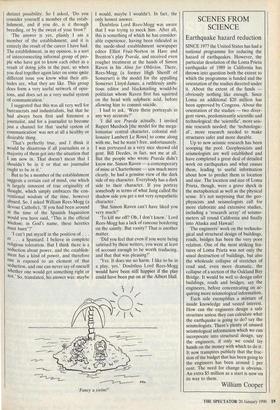SCENES FROM SCIENCE
Earthquake hazard reduction
SINCE 1977 the United States has had a national programme for reducing the hazard of earthquakes. However, the particular desolation of the Loma Prieta earthquake of 1989 in California has thrown into question both the extent to which the programme is funded and the orientation of the studies directed under it. About the extent of the funds obviously nothing like enough. Since Loma an additional $20 million has been approved by Congress. About the orientation of the studies — two diver- gent views, predominantly scientific and technological: the 'scientific', more seis- mic research needed; the 'technologic- al', more research needed to make structures safer and more durable.
Up to now seismic research has been scooping the pool. Geophysicists and seismologists are well established and have completed a great deal of detailed work on earthquakes and what causes them, leading to useful information about how to predict them in location and size. The location and size of Loma Prieta, though, were a grave shock in the metaphorical as well as the physical sense. It's not surprising that the geo- physicists and seismologists call for more elaborate and extensive studies, including a 'research array' of seismo- meters all round. California and finally into Alaska and Hawaii!
The engineers' work on the technolo- gical and structural design of buildings, roads, bridges has been the very poor relation. One of the most striking fea- tures of Loma Prieta was not only the usual destruction of buildings, but also the wholesale collapse of stretches of road and, even more dramatic, the collapse of a section of the Oakland Bay Bridge. It would be well to design safer buildings, roads and bridges, say the engineers, before concentrating on ac- quiring more seismological information. Each side exemplifies a mixture of inside knowledge and vested interest. How can the engineers design a safe structure unless they can calculate what the earthquake is going to do? say the seismologists. There's plenty of unused seismological information which we can incorporate into structural design, say the engineers, if only we could lay hands on the money with which to do it. It now transpires publicly that the frac- tion of the budget that has been going to the engineers has been around 1 per cent. The need for change is obvious. An extra $5 million as a start is now on its way to them.
William Cooper


















































 Previous page
Previous page